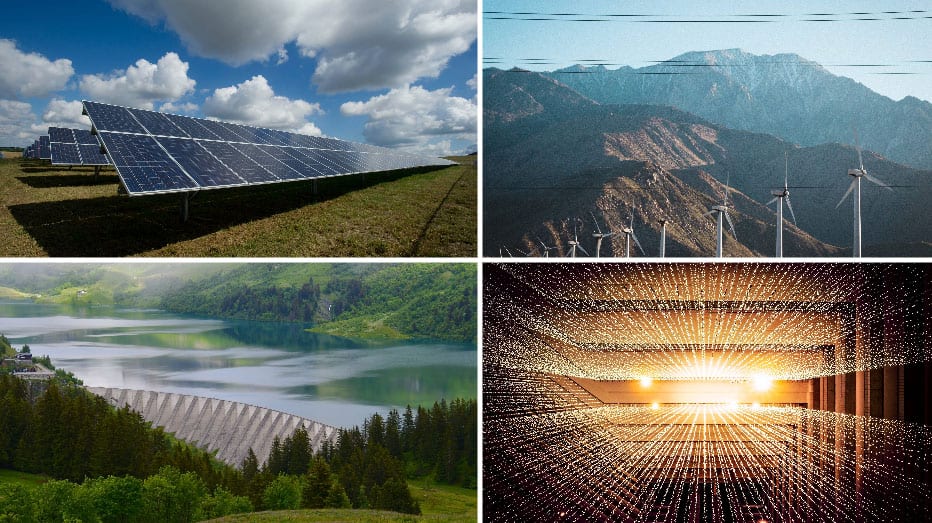Energy production and consumption are responsible for more than 75% of the EU’s greenhouse gas emissions. To achieve the climate targets for 2030 and climate neutrality by 2050, the energy system of the EU and thus also of the Alpine region must become climate neutral.
Various strategies define how the 2030 and 2050 targets are to be achieved: the EU strategy for the Alpine region, the EU Green Deal, the EU clean energy for all Europeans package and the INSPIRE directive. The CERVINO energy data platform supports the Alpine regions in realizing these strategies and thus achieving climate targets and climate neutrality. It becomes possible to plan, implement and permanently monitor the energy transition.
The EU Strategy for the Alpine Region, the EUSALP, exists specifically for the Alps. Action Group 9 (AG9) of the EUSALP is responsible for the topics of energy efficiency and the use of regional renewable energies. Its members are experts from all participating countries from public, private and associated organizations. The aim of AG9 is to make the Alps a model region for energy efficiency and renewable energy. In addition, AG9 aims to facilitate data exchange at macro-regional level and establish an energy observatory for the EUSALP region.
To become a model region for energy efficiency and renewable energies, data is required as a planning basis. At the same time, despite surveys in 2017 and 2019 initiated by AG9, little or no energy data has been collected in a number of Alpine regions to date. And data is usually not even exchanged between regions within a country. This energy data will soon be available on the CERVINO online platform, though, for example on the production of renewable energy or on energy consumption across the Alps. In order to use the platform as a permanent energy observatory that maps the energy transition, CERVINO is working with the regions to ensure that the energy data flows into the platform as automatically as possible in the future. All of this helps the Alpine neighbors in their transformation into a model region, where energy data is available as a basis for planning, implementing and monitoring projects.
Other overarching strategies that CERVINO is supporting the Alpine region in implementing are the “EU Green Deal” and the “EU clean energy for all Europeans package”. Both strategies contribute to achieving the vision of a climate-neutral Europe by 2050.
The EU Green Deal is about creating the transition to a modern, resource-efficient and competitive economy that, among other things, no longer emits any net greenhouse gases by 2050. The energy system plays a central role in this. The EU clean energy for all Europeans package is a set of rules for decarbonizing the energy system. Among other things, it contains a binding target for the expansion of renewable energy sources – 32% renewable energy sources in the EU energy mix by 2030 – and defines energy efficiency as a central goal.
Reliable energy data is needed to ensure that the economy also in the Alpine region is climate-neutral by 2050. This is the only way to plan a renewable and efficient energy supply in a targeted manner. On the CERVINO platform, stakeholders such as EUSALP members, ministries, energy agencies, infrastructure providers and companies from the region will soon find a collection of up-to-date energy data: They are stored in such a way that they can be compared spatially and over time between the various Alpine countries. And so that all stakeholders can work with it easily, the data is presented visually via a map of the Alpine region or via a dashboard and shows an energy portrait of the respective region. The platform is therefore also suitable for planning cross-border climate-friendly energy projects. And in the future, the platform will enable the development towards the goal of a climate-neutral economy to be reviewed again and again. Once it has been established as an energy observatory and data from the regions is regularly fed in, it will then be possible to read off the energy savings achieved or the expansion of renewable energies in the individual regions, for example.
Another strategy the CERVINO energy data platform supports Alpine stakeholders in implementing is the EU’s INSPIRE directive. The aim of the directive is for spatial environmental information to be shared between public sector organizations in order to support environmental policy. CERVINO contributes to the implementation of the directive by mapping regional and supra-regional energy data and making it available to the general public and public organizations.
Are you working on achieving climate targets and climate neutrality in the Alps? Then make use of CERVINO’s Alpine energy data platform! The platform will be published shortly.
Find out more about the project CERVINO and the energy data platform on our website www.alpine-space.eu/project/cervino/, LinkedIn, and YouTube
CERVINO alpine energy data platform: https://cervino.eurac.edu



